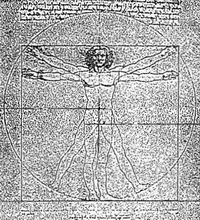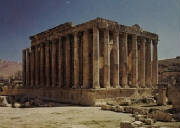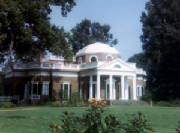|

Perhaps the oldest known form of structured architecture is "Classical Architecture." Dating back milleniums, the person who
is considered to be the father of modern classical architecture is Vitruvius, a Roman mathemetician, engineer and architect
who lived in the first century BCE. However, it can be accurately stated that the principles of classical architecture were
used as far back as 1000 BCE in Solomon's Temple at Jerusalem. Many scholars even claim that Noah's Ark was built on the proportions
employed centuries later in Solomon's Temple and in more recent classical design.
It is Vitruvius who established the scale, proportions and orders that we know today as classical architecture. He did this
based on the human scale of an average man. You may not realize it, but you have probably seen drawings based on the writings
of Vitruvius, including the one shown here. The human scale that he describes is today called "ergonomics" and is the study
of designing buildings, furnishings and appurtenances for ease of human use. The principle of ergonomics in classical architecture
is to ensure that whatever is built will look and feel comfortable to the human eye as well as the way in which it is used.
Throughout history, classical architecture was taught to students around the world and its principles applied everywhere.
The most famous school that taught classical architecture was the Ecole des Beaux Arts in France. Many notable architects
who practiced until the early twentieth century studied there. Ecole des Beaux Arts has long since closed its doors, leaving
the education of classicism to other post-secondary schools. Since World War 2, classicism has largely been abandoned in favor
of modernism and post-modernism and there is a great rift between modernists/postmodernists and classicists. Very few colleges
and universities teach classicism today, much to the chagrin of today's purists in classicism.
In 1992, a small group of classicists banded together to form an organization that would not only promote, but educate design
professionals, builders and others regarding classical architecture. That organization, the Institute of Classical Architecture,
has since merged with another organization, Classical America and is now also forming an alliance with the Institute of Traditional
Architecture.
ICA/CA is also allied with the American Institute of Building Design and conducts courses in classical architecture through
the regional societies of AIBD. ICA/CA will also teach its courses and the ITA courses through AIBD.

The basic building blocks of classical architecture are the mouldings. Every piece of construction in a classically designed
home will have the same basic moulding shapes, which will be scaled and proportioned according to the order that is selected
for the design of the entire building.
There are four basic orders (column styles) that are used to design any given building. They are: Tuscan, Doric, Ionic and
Corinthian. Composite and Temple of Winds are variations on the Corinthian order. (See diagram to the left) The Tuscan and
Doric orders are the masculine orders and are generally used for most short buildings. The Ionic and Corinthian orders are
the feminine orders and are generally used for most taller structures.
The order is selected based on the size and mass of the home and the building exterior will be developed around the theme
of the selected order.

It is important to note that "classical" is not necessarily a style of architecture, although in contemporary vernacular,
most people consider it to be so. Really, classical is a way of designing that reflects the scale and proportions of the original
classicists. In fact, we can design in any style, whether it be contemporary, postmodern (although I doubt anyone would),
"Mediterranean," Romantic (Castle), Victorian, French Country, English Manor, Tudor, Asian pagoda, Cape Cod, or
nearly any other style, and it will look right as long as it maintains the scale and proportion specified in classical architecture.
The key ingredients, therefore, and the primary principles can be explained as the secret of those two important words:
scale and proportion. If a house is not scaled or proportioned properly, it will not look or feel right. This principle applies
to the interior as well as the exterior of any home, designed in any style. Admittedly, it is not easy to achieve, but a well-trained
classical designer or architect can achieve successful results with enough time and thought put into the design.

Perhaps the most famous classically designed structure is the Parthenon, located at the Areopagus, sitting atop the Acropolis
just outside Athens, Greece. It has been described as the "perfect building" in that it is perfect in size, scale and proportion.
It is a testament to the timelessness of classical architecture and is visited by more people each year than any other tourist
attraction except Disney World.
No one knows exactly who designed and built it, but it is said to date from circa 500 BCE and is considered a masterpiece
and a model for future classical buildings. It was originally designed as a temple to a Greek god, and the Christian apostle
Paul lectured to Greek philosophers there. (See the Bible book of Acts, chapter 17) Although it is not complete any longer
due to age, it has survived the ravages of war, acid rain and earthquakes. The government of Greece is working diligently
to preserve this masterpiece of classicism.
One of the most notable classicists was an Italian Renaissance architect of the sixteenth century named Andrea Palladio. True
"Palladian" architecture is a derivative of his work. He was a very prolific designer and his work can be seen throughout
Italy. Palladio's most famous work is Villa Rotunda and is a must-see for visitors to Italy.
Andrea Palladio was highly sought after in his time by Italian nobility and has been a mentor for other notable classical
architects, including Thomas Jefferson. Since I consider Jefferson to be my primay mentor (apologies to John Henry), and Jefferson
considered Palladio to be his primary mentor, I suppose you could say that I also consider Palladio to be my mentor as well.

Thomas Jefferson is probably the most notable American classicist, designing many public and private buildings in the American
south and east. Included in his prolific work is his own private residence, Monticello, now a museum and a part of the National
Trust for Historic Preservation. Jefferson spent most of his adult life designing, building, redesigning, refining and remodeling
Monticello and he died there. Monticello is my favorite residential dwelling in this country.
|
